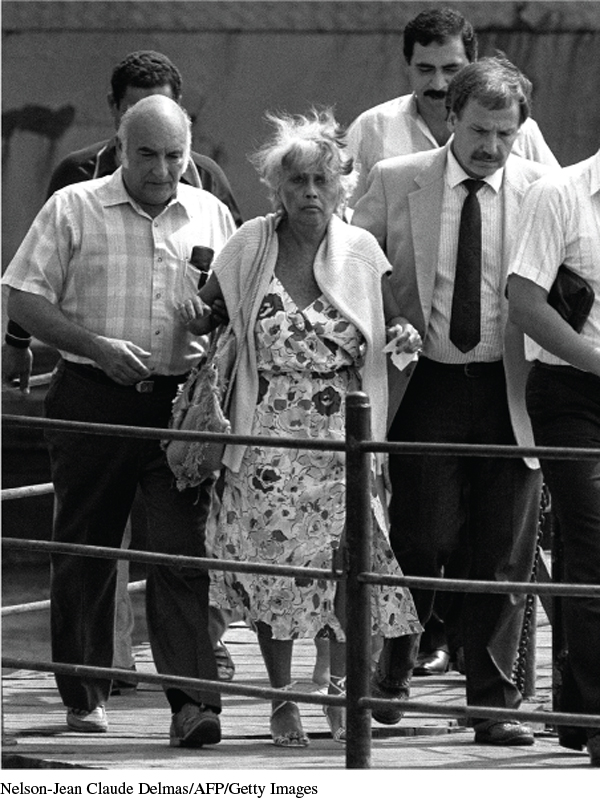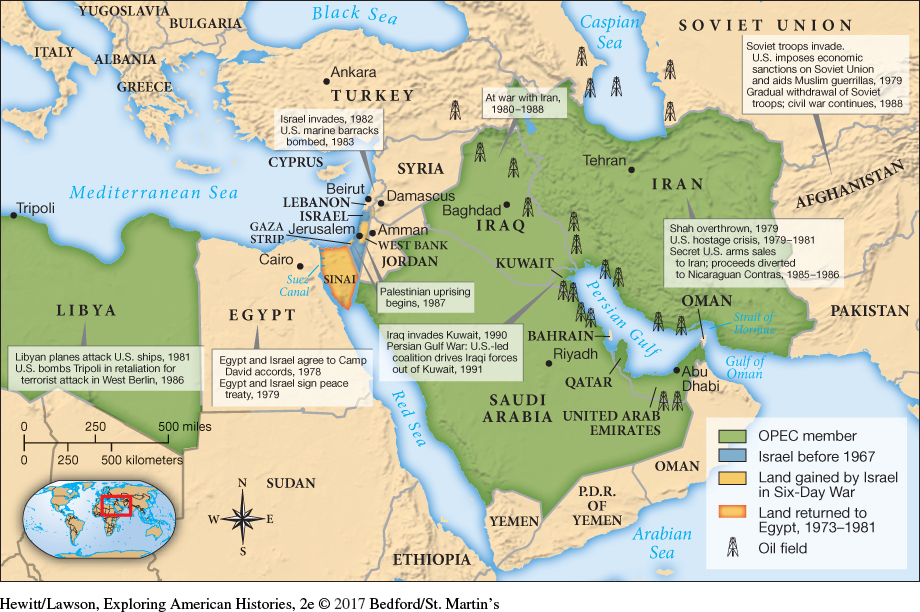Fighting International Terrorism
Two days before the Grenada invasion in 1983, the U.S. military suffered a grievous blow halfway around the world. In the tiny country of Lebanon, wedged between Syrian occupation on its northern border and the Palestine Liberation Organization’s (PLO) fight against Israel to the south, a civil war raged between Christians and Muslims. Reagan believed that stability in the region was in America’s national interest. With this in mind, in 1982 the Reagan administration sent 800 marines, as part of a multilateral force that included French and Italian troops, to keep the peace. On October 23, 1983, a suicide bomber drove a truck into a marine barracks, killing 241 soldiers. Reagan withdrew the remaining troops.

The removal of troops did not end threats to Americans in the Middle East. Terrorism had become an ever-present danger, especially since the Iranian hostage crisis in 1979–1980. In 1985, 17 American citizens were killed in terrorist assaults, and 154 were injured. In June 1985, Shi’ite Muslim extremists hijacked a TWA airliner in Athens with 39 Americans on board and flew it to Beirut. That same year, PLO members hijacked an Italian cruise ship in the Mediterranean. Before the dangerous situation was resolved, an elderly American man in a wheelchair was murdered and his body dumped in the sea.
In response to the 1985 PLO cruise ship attack, the Reagan administration targeted the North African country of Libya for retaliation. Its military leader, Muammar al-Qaddafi, supported the Palestinian cause and provided sanctuary for terrorists. The Reagan administration had placed a trade embargo on Libya, and Secretary of State Shultz remarked: “We have to put Qaddafi in a box and close the lid.” In 1986, after the bombing of a nightclub in West Berlin killed 2 American servicemen and injured 230, Reagan charged that Qaddafi was responsible. In late April the United States retaliated by sending planes to bomb the Libyan capital of Tripoli. Following the bombing, Qaddafi took a much lower profile against the United States. Reagan had demonstrated his nation’s military might despite the retreat from Lebanon (Map 28.1).

In the meantime, the situation in Lebanon remained critical as the strife caused by civil war led to the seizing of American hostages. By mid-1984, seven Americans in Lebanon had been kidnapped by Shi’ite Muslims financed by Iran. Since 1980, Iran, a Shi’ite nation, had been engaged in a protracted war with Iraq, which was ruled by military leader Saddam Hussein and his Sunni Muslim party, the chief rival to the Shi’ites. With relations between the United States and Iran having deteriorated in the aftermath of the 1979 coup, the Reagan administration backed Iraq in this war. The fate of the hostages in Lebanon, however, motivated Reagan to make a deal with Iran. In late 1985 Reagan’s national security adviser, Robert McFarlane, negotiated secretly with an Iranian intermediary for the United States to sell antitank missiles to Iran in exchange for the Shi’ite government using its influence to induce the Muslim kidnappers to release the hostages.
Had the matter ended there, the secret deal might never have come to light. However, NSC aide Lieutenant Colonel Oliver North developed a plan to transfer the proceeds from the arms-for-hostages deal to fund the Contras in Nicaragua and circumvent the Boland Amendment, which prohibited direct aid to the rebels. Despite opposition from Secretary of State Shultz, Reagan liked North’s plan, although the president seemed vague about the details, and some $10 million to $20 million of Iranian money flowed into the hands of the Contras.
In 1986 information about the Iran-Contra affair came to light. See Document Project 28: The Iran-Contra Affair. In the summer of 1987, televised Senate hearings exposed much of the tangled, covert dealings with Iran. In 1988 a special federal prosecutor indicted NSC adviser Vice Admiral John Poindexter (who had replaced McFarlane), North, and several others on charges ranging from perjury to conspiracy to obstruct justice. Reagan took responsibility for the transfer of funds to the Contras, but he managed to weather the political crisis.
Exploring American HistoriesPrinted Page 941
Exploring American Histories Value EditionPrinted Page 696
Chapter Timeline